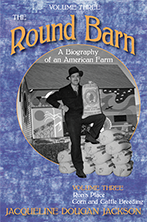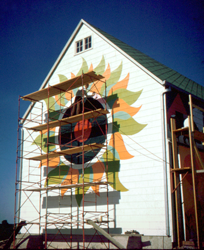Announcing the publication of Jackie Jackson's life work:
“Jackie Jackson throws open the Round Barn doors at the Dougan family farm to tell us an American story. She gives us a rich history of farm life at the mercy of the forces of science and the market but grounded in rock-solid Wisconsin values.” Dick Durbin, U.S. Senator
Chapter from VOLUME 3
This story is from The Round Barn, Vol 3. Want to read more stories from the Round Barn? Order Volume 3 below or enter our discount code.

VOLUME THREE:
Ron's Place
Hybrid Corn Processing

Frank Boggs painting the sunburst.
Mural
Jackie is living in the East; it's the mid '50s. She comes home for a visit. Daddy has just completed his new seed processing building. He’s proud of it. So are all the workmen who helped with the concrete and construction. The Sandinavians especially took many photographs to send home, to show off their toil.
The new building stands on the edge of the other farm buildings at Chez Nous. It's three stories tall. Coming up Colley Road, the farm on the horizon, you used to be able see the clump of trees that hid the house; and behind them, a long low white building with a green roof that Daddy used in his corn operations. That building partially hid the large barn beyond it, the roof of which rose above the long low building. From Colley Road the farm was an aesthetically pleasing sight. Mother fancied that long low building, its proportions and lines. Now the new building hides everything. Mother doesn't like the new building. Its lines are ugly. It spoils the view.
At dinner, Mother is talking about the new seed house. She's telling Jackie how she doesn't like it, how it hides the pleasing lines of the old seed building. "It's ugly," Mother repeats.
"I'm tired of your talking against my seed house," says Daddy. "It's going to be the most beautiful building on the place. I'm going to put a mural on it."
It's obvious to Jackie that the idea has just popped into Daddy's head. She thinks it an interesting one, but she doesn't take him seriously. She grins.
Mother does believe him. She always believes Daddy, even the most preposterous things. Mother is gullible. But she tries to dissuade him.
"You can't do that," she says. "How could you get a mural on that building? What sort of mural? You're not going to do that."
"Yes, I am," insists Daddy. Jackie grins wider. Mother's raising obstacles has caused the idea to dig in like a tick on a dog.
Daddy leaves the table and goes to the phone. He dials a number. "Hello, Frank? Frank Boggs?"
Frank Boggs is an artist. He's head of the Art Department at Beloit College. His specialty is murals. Large murals.
"I have a wall out here," says Daddy, "as big as any space you'll find between Chicago and Mexico City. Would you be interested in putting a mural on it? I'll supply the scaffolding and the paint and all the chocolate milk you can drink."
There's a silence while Daddy listens to Frank's response. Jackie and Mother wait. Then Daddy laughs. "All right," he says, "I'll be seeing you."
He returns to the table. "Frank Boggs is going to paint a mural on my barn."
Jackie is delighted. Mother is mollified. "Well, since it's Frank Boggs," she says.
Frank comes out with a class. They examine the surface of the seed barn. Then they go all over the farm. Daddy shows them the cows, the hives, the contours in the fields, the alfalfa, the seed corn operation from start to finish. They learn about insect control and water cycles. They all drink chocolate milk before returning to college. Plans are drawn, featuring the various aspects of the farm. The mural will tell the story of hybrid seed corn and modern farming. When the sketches are complete the class comes out to the farm during their art periods. The college has furnished the scaffolding. Daddy has bought paint in all the colors Frank has requested. Cases of half-pints of chocolate and white milk and orange drink are iced down inside the seed processing building.
Working in pairs the students transfer their plans to the building. They swarm over the side. They ingeniously utilize the row of small windows as the fuselage of a contour tractor, thus making the windows an integral part of the mural. The huge sliding doors tell the story of the corn operations. The little door alongside is the seed sorting tray. They paint pigs and cows and crop dusting and bees. They tell the story of modern farming.
Their enthusiasm is so great that they spill over onto the front of the adjacent long, low building. One student paints a medallion-like scene of two black and white cows and a calf, intertwined almost yin and yang. A Japanese student paints an opposing medallion of a foxy fox herding a flock of chickens. The fox has a distinct oriental cast to his features, as do the chickens. Even Frank Boggs' family is drawn into the sport. They paint varied grasses on the panel of windows on the long low building's wide doors–brome, rye, timothy, alfalfa. Everybody, every day, drinks copious quantities of chocolate milk. It’s a grand social time for the community. People drive from town and the surrounding countryside to watch what’s happening to Ron and Vera’s barn.
Frank Boggs saves the three-story end of the seed house for himself. It rises to a peak. "I'm going to paint a sunburst on it," he tells Daddy. "Where would agriculture–or anything–be without the sun?"
He begins on a day when Daddy's out of town. When Daddy returns it's sunset, and on the end of the building he sees a huge black ball. The center of the ball, unpainted, sports a large figure 8.
"I wonder if Frank is trying to tell me something?" asks Daddy.
Frank goes on to turn the 8-ball into a gigantic sunburst. It has a red core surrounded by black. Orange and green and turquoise rays flame out from the center. The sunburst is so bright it vibrates when you look at it. It hurts your eyes, like the real sun. It's magnificent. It can be seen across the valley from town.
The Milwaukee Journal comes and takes pictures of the mural and sunburst in progress; they make it a feature story. The work takes a number of weeks to complete. At the finish the students all sign their names on the building. It's been a glorious project.
Daddy is delighted with his seed house. Mother is delighted, too; she no longer laments over losing the long low lines of the hidden building. She takes credit for the whole thing because she complained so persistently about the ugliness. Townspeople are intrigued. Strange cars come up the lane, look at the barn, and drive out again. Other newspapers publish pictures. The mural is a huge success.
That year's photo Christmas card is a booklet, mostly views of various stages in the progress of the mural. On the back page Daddy includes a picture of himself on the scaffold, and underneath is printed, "R. A. Dougan, Patron of the Arts."
A few years go by. The mural is still magnificent, but the colors have muted a little. The startling sunburst is not quite so vibrant. Jackie is again home for a visit. She's going over to see her former art teacher, Frank Boggs. Daddy shouts as she leaves, "Ask Frank how I can make my sunburst stop fading!"
A few hours later Jackie returns.
"Well?" Daddy asks. "Did you remember to ask? What did Frank say?"
Jackie answers. "He says for you to tell the sun to stop shining."
